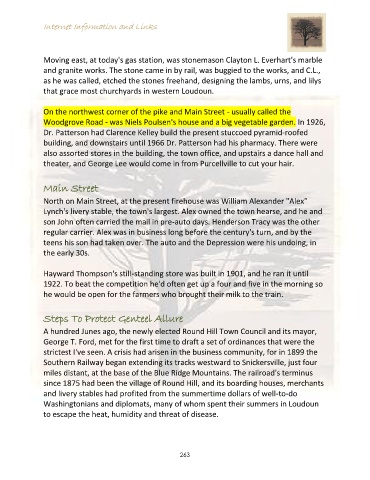Page 263 - Family History
P. 263
Internet Information and Links
Moving east, at today's gas station, was stonemason Clayton L. Everhart's marble
and granite works. The stone came in by rail, was buggied to the works, and C.L.,
as he was called, etched the stones freehand, designing the lambs, urns, and lilys
that grace most churchyards in western Loudoun.
On the northwest corner of the pike and Main Street - usually called the
Woodgrove Road - was Niels Poulsen's house and a big vegetable garden. In 1926,
Dr. Patterson had Clarence Kelley build the present stuccoed pyramid-roofed
building, and downstairs until 1966 Dr. Patterson had his pharmacy. There were
also assorted stores in the building, the town office, and upstairs a dance hall and
theater, and George Lee would come in from Purcellville to cut your hair.
Main Street
North on Main Street, at the present firehouse was William Alexander "Alex"
Lynch's livery stable, the town's largest. Alex owned the town hearse, and he and
son John often carried the mail in pre-auto days. Henderson Tracy was the other
regular carrier. Alex was in business long before the century's turn, and by the
teens his son had taken over. The auto and the Depression were his undoing, in
the early 30s.
Hayward Thompson's still-standing store was built in 1901, and he ran it until
1922. To beat the competition he'd often get up a four and five in the morning so
he would be open for the farmers who brought their milk to the train.
Steps To Protect Genteel Allure
A hundred Junes ago, the newly elected Round Hill Town Council and its mayor,
George T. Ford, met for the first time to draft a set of ordinances that were the
strictest I've seen. A crisis had arisen in the business community, for in 1899 the
Southern Railway began extending its tracks westward to Snickersville, just four
miles distant, at the base of the Blue Ridge Mountains. The railroad's terminus
since 1875 had been the village of Round Hill, and its boarding houses, merchants
and livery stables had profited from the summertime dollars of well-to-do
Washingtonians and diplomats, many of whom spent their summers in Loudoun
to escape the heat, humidity and threat of disease.
263

